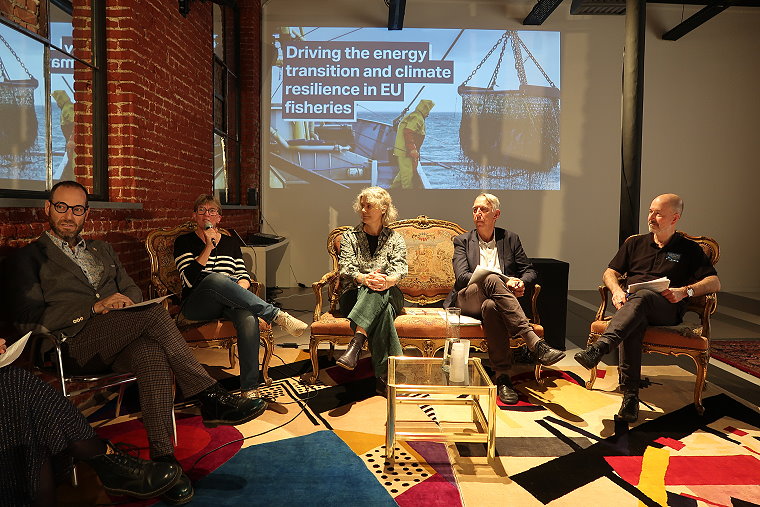 The energy transition in the fisheries sector is not just about reducing emissions and fighting climate change—it's about ensuring the sector remains competitive on the global stage and stays resilient in the long-term. Organised by ClientEarth, Oceana and Seas at Risk, this event of the EU Ocean Week took place Thursday, 3rd October 2024, at lunch time at the exhibition space of Talk CEC, 141-143 Chaussée de Wavre, 1050 Ixelles, Brussels.
The energy transition in the fisheries sector is not just about reducing emissions and fighting climate change—it's about ensuring the sector remains competitive on the global stage and stays resilient in the long-term. Organised by ClientEarth, Oceana and Seas at Risk, this event of the EU Ocean Week took place Thursday, 3rd October 2024, at lunch time at the exhibition space of Talk CEC, 141-143 Chaussée de Wavre, 1050 Ixelles, Brussels.
Adam Weiss, European Director Programs of ClientEarth moderated the session and started the conversation with a bang: While many people were scrambling to seek ways to reduce their CO2 emissions and material consumption, the European Council representing EU Member States had just gone public with the suggestion for another 20 years of tax exemption on fisheries fuel! - the very opposite of the mandate given to the World Trade Organization (WTO) to stop harmful fisheries subsidies funding overcapacity and overfishing with public resources.
The panelists immediately chimed into the debate - starting with Caroline Roose, former MEP and member of the Fisheries Committee, who referred to the Energy Roadmap 2050 of the European Commission as a major drive towards decarbonisation. As for the fisheries sector, among the measures with multiple positive effects would be stopping trawling in nominal marine protected areas. She reminded the audience that the Common Fisheries Policy (CFP) contained a host of good measures, including Art 17, which encourages Member States (MS) to allocate fishing rights according to environmental, economic and social criteria, rather than by cementing historical rights of industrial fisheries as most MS do. The paragraph specifically encourages MS “to provide incentives to fishing vessels deploying selective fishing gear or using fishing techniques with reduced environmental impact, such as reduced energy consumption or habitat damage”. Catalunya has thus allocated 10% of fishing days for low impact fisheries. But a lot more could and should be done.

Didier Gascuel of Agrocampus Ouest in Rennes, France, highlighted the large footprint of European fishing fleets on juveniles, fuel consumption and associated CO2 emissions and employment. Trawling accounted for 64% of CO2 emissions, but only 40% of the catch. That meant for one kg of trawled fish about 2 l of fuel were necessary amounting to 3 to 5 kg of CO2. Conversely, small-scale coastal fishers using passive gear generated 1 kg of CO2 or less for the same amount of fish.
He commented that reduction of bottom trawling was already underway as it was increasingly unprofitable as landings had halved over the last 15 years. Many vessels were only still operating because of public subsidies. While nowadays accounting for only a small percentage of European landings, SSF were mostly more profitable and had higher added value of their catches.
 Didier cautioned, however, that SSF would not benefit from this state of affairs unless there was a change in policy currently in favour of industrial fishing. He strongly recommended to emphasise low impact methods also for vessels larger than 12 meters fishing further off-shore. Decarbonisation and other recovery methods were not to trigger more imports.
Didier cautioned, however, that SSF would not benefit from this state of affairs unless there was a change in policy currently in favour of industrial fishing. He strongly recommended to emphasise low impact methods also for vessels larger than 12 meters fishing further off-shore. Decarbonisation and other recovery methods were not to trigger more imports.
Friederike Ziegler of the RISE Research Institutes in Sweden asked, how are fisheries going to be in 2050. She reinforced Didier's message that size of fishing vessels was not the most relevant criterion, but making sure fishing minimised its environmental impact. She argued that effectively applying the rules and regulations of the reformed CFP should reward low impact fishers, encourage to use novel fuels and allow resources to bounce back.
Brian O'Riordan, Senior Policy Adviser of Low Impact Fishers Europe (LIFE), recalled that about 3% of global CO2 emissions were generated by the fisheries sector. With resources in sub-optimal conditions 40% of imported fish and fisheries products came from socially and environmentally questionable sources. Total imports accounted for 70% of consumption.
He regretted that Europe had no clear plan for the fisheries of the future. He argued that a well-thought out transition was needed to free the region from its almost complete dependence on fossil fuels. Success needed a differentiated approach. At the moment only 3% of the Fisheries Fund was invested to good results through Fisheries Local Action Groups (FLAGs). In the highly concentrated food sector, it could be justified to support producer organisations so that SSF were sustainable and competitive in producing high quality fish. Brian advocated that the 12 miles national waters should be reserved for low impact SSF under a co-management regime. That would strengthen local sustainable food systems. He also mused that 24 kg per caputa fish consumption in Europe was rather high. A bit less but better quality would serve a healthy diet more than the emphasis on quantity now.
No shortage of ideas how to decarbonise while helping marine ecosystems to recover lost productivity, while making small-scale fishing attractive again and delivering quality fish.
Text and photos by Cornelia E Nauen.








